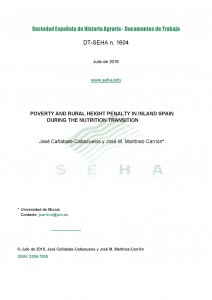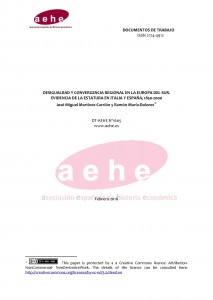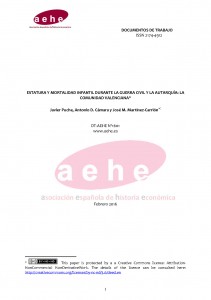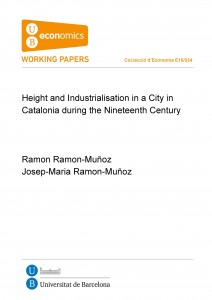 José Miguel Martínez-Carrión & Cañabate-Cabezuelos (2016): “Poverty and rural height penalty in inland Spain during the nutrition transition”, MPRA Paper No. 74356.
José Miguel Martínez-Carrión & Cañabate-Cabezuelos (2016): “Poverty and rural height penalty in inland Spain during the nutrition transition”, MPRA Paper No. 74356.
Abstract: The article analyses nutritional inequalities and stunting in inner rural Spain from a case study carried out in Castile-La Mancha. The examination of the height of military draftees explores the gap between urban and rural populations and analyses the evolution of growth patterns in different habitational contexts. The results indicate that stunted growth and undernourishment were pervasive in the two initial decades of the 20th century, that the situation improved slightly in the 1920s and the first half of the 1930s, and that in the 1940s and 1950s the conditions again deteriorated considerably. Stunted growth was significant especially in rural areas, which were particularly penalized during Francoism. Height increased considerably in the 1960s and 1970s and although this improvement also reached the rural areas the gap that separated the countryside and the urban areas did not disappear until the early 1980s. The data suggests that a poor and limited diet, the economic policies and the social assistance-related institutional framework were key factors in the evolution of growth. Finally, the results also stress the need to extend the study to adolescent circumstances, and not only children, as well as the need to investigate social inequality among different professional groups during the nutritional transition.
 José Miguel Martínez-Carrión & Cañabate-Cabezuelos (2016): “Poverty and rural height penalty in inland Spain during the nutrition transition”, DT‐SEHA no.1604.
José Miguel Martínez-Carrión & Cañabate-Cabezuelos (2016): “Poverty and rural height penalty in inland Spain during the nutrition transition”, DT‐SEHA no.1604.
Abstract: The article analyses nutritional inequalities and stunting in inner rural Spain from a case study carried out in Castile-La Mancha. The examination of the height of military draftees explores the gap between urban and rural populations and analyses the evolution of growth patterns in different habitational contexts. The results indicate that stunted growth and undernourishment were pervasive in the two initial decades of the 20th century, that the situation improved slightly in the 1920s and the first half of the 1930s, and that in the 1940s and 1950s the conditions again deteriorated considerably. Stunted growth was significant especially in rural areas, which were particularly penalized during Francoism. Height increased considerably in the 1960s and 1970s and although this improvement also reached the rural areas the gap that separated the countryside and the urban areas did not disappear until the early 1980s. The data suggests that a poor and limited diet, the economic policies and the social assistance-related institutional framework were key factors in the evolution of growth. Finally, the results also stress the need to extend the study to adolescent circumstances, and not only children, as well as the need to investigate social inequality among different professional groups during the nutritional transition.
 José Miguel Martínez-Carrión (2016): “El bienestar biológico de los españoles durante la Restauración: un análisis provincial”, DT‐SEHA no.1601.
José Miguel Martínez-Carrión (2016): “El bienestar biológico de los españoles durante la Restauración: un análisis provincial”, DT‐SEHA no.1601.
Abstract: Anthropometric indicators provide valuable information on nutritional status and living standards. This paper uses these indicators to explore the biological wellbeing of Spaniards during the Bourbon Restoration. From a sample of anthropometric data composed of 119,571 soldiers at age 20, measured between 1903 and 1906 -cohorts which were born between 1883 and 1886-, it presents the provincial results of height, weight, and BMI values and other aspects of biological living standards. Average heights are compared with previous periods to check the biological well-being during the second half of the nineteenth century. Anthropometric outcomes (height, weight and chest circumference) show the inequality of nutritional status in Spanish geography and suggest the influence of environmental and institutional factors in human development.
 José Miguel Martínez-Carrión & Ramón María-Dolores (2016): “Desigualdad y convergencia regional en la Europa del Sur. Evidencia de la estatura en Italia y España, 1850-2000”, DT‐AEHE no.1605.
José Miguel Martínez-Carrión & Ramón María-Dolores (2016): “Desigualdad y convergencia regional en la Europa del Sur. Evidencia de la estatura en Italia y España, 1850-2000”, DT‐AEHE no.1605.
Abstract: This paper analyzes the growth of height and its regional variability in Spain and Italy, among the generational cohorts of 1850 and 1980. Using male height data drawn from the military enlistment records of the period between 1870 and 2000, this paper explores inequality and regional convergence in the two countries. This long period was characterised by economic growth and the expansion of human welfare. Regional inequality and convergence are analysed using sigma and beta convergence, a methodology based on panel data to obtain the speed of convergence. The results show that in 1850 in both countries the height measurements started at low levels, but the two countries recorded a significant increase in the average height over the long term, which became more intense in Italy as from the beginning of the twentieth century, and in Spain from 1950. Therefore, there was divergence in the first half of the century and strong convergence at the end of the century. The regional inequality was more significant in the Italian case. Processes of regional convergence can be observed in both countries during the second half of the twentieth century, but at the end of the period, inequality was lower in Spain than in Italy.
 Javier Puche, A. Cámara & José Miguel Martínez-Carrión (2016): “Estatura y mortalidad infantil durante la Guerra Civil y la autarquía: la Comunidad Valenciana”, DT‐AEHE no.1601.
Javier Puche, A. Cámara & José Miguel Martínez-Carrión (2016): “Estatura y mortalidad infantil durante la Guerra Civil y la autarquía: la Comunidad Valenciana”, DT‐AEHE no.1601.
Abstract: This article analyzes the biological well-being among male conscripts in the region of Valencia (Eastern Spain) during the Civil War and the subsequent period of autarchy during Franco’s dictatorship. For this purpose we use 124,284 height records from 20yr conscripts born between 1900 and 1954 from ten municipalities along with region-level infant mortality rates. Results show that the mean height cohort trend slowed down meaningfully among cohorts that were raised in the context of the Spanish Civil War and/or during the autarchic postwar decade. The height series at the local level evidence very dissimilar magnitudes of the nutritional crisis in this Spanish region. The worsening of the net nutritional status was greater in industrial towns as well as in rural areas with some agriculture specialization. By contrast, the impact of war and postwar, as measure by height, was negligible in other areas. Finally, although infant mortality declined during the decade of 1940s the combined analysis of height and mortality uncovers that such decline was likely associated with medical advances and interventions in the field of hygiene rather than with improved nutrition.
 Ramon Ramon-Muñoz & Josep-Maria Ramon-Muñoz (2015): “Height and Industrialisation in a City in Catalonia during the Nineteenth Century”, UB Economics Working Papers 2015/334.
Ramon Ramon-Muñoz & Josep-Maria Ramon-Muñoz (2015): “Height and Industrialisation in a City in Catalonia during the Nineteenth Century”, UB Economics Working Papers 2015/334.
Abstract: Drawing on anthropometric information, this article investigates the evolution of the biological standard of living in nineteenth-century Catalonia. We focus on the city of Igualada, one of Catalonia’s main textile centres in the early part of the century. The results show a decline in the height of males born between the 1830s and the 1860s, the period in which factory-based industrialisation emerged and became consolidated. The article also suggests that height inequality rose during the third quarter of the nineteenth century. The empirical evidence gathered provides further support for the pessimistic view of the evolution of the standard of living during the early stages of industrialisation.